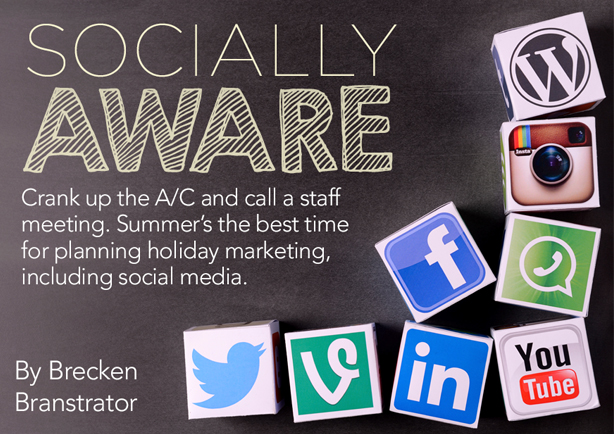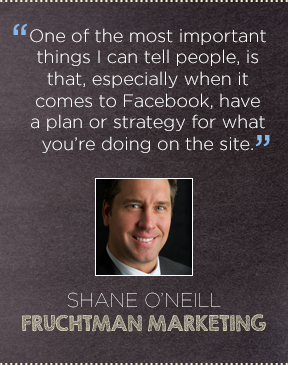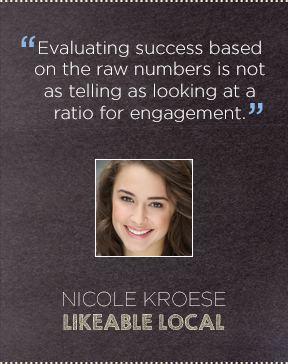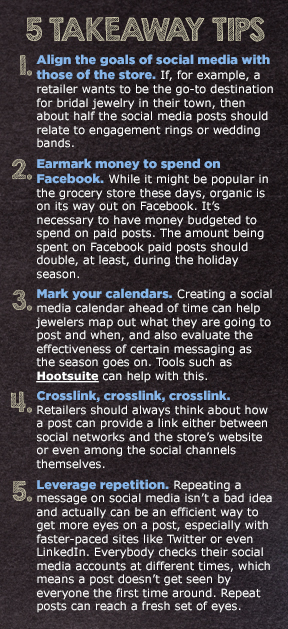




Social media provides retailers today with the opportunity not only to reach customers whom they wouldn’t have been able to reach before, but also to engage and interact with them.
But being successful on these channels requires more than just throwing a post up every now and then. Brand messages and goals have to be thought out and methodical, and for retailers looking to have a social media strategy ready to go for the all-important holiday season, now is the time to get their accounts in ship shape.
National Jeweler talked with Shane O’Neill, vice president at Fruchtman Marketing, and Nicole Kroese, director of marketing and partnerships at Likeable Local, about how jewelers can use the summer time to start putting together an attack plan for their social media accounts.
“One of the most important things I can tell people, is that, especially when it comes to Facebook, have a plan or strategy for what you’re doing on the site,” O’Neill says.
For each jeweler, the social media sites on which they set up accounts really will vary on what’s best for the business. What’s more important is having a few that are done well and engage the audience rather than trying to spread resources thin and sacrificing engagement and reach in the process.
The other thing retailers need to keep in mind, O’Neill says, is that social media “isn’t just some plaything”—they’re sophisticated sites that are being run by large, publicly traded companies.
Treating them as real media outlets where consumers can be reached is the first step to getting results.
Be consistent and boost
One of the most important aspects of establishing a following and engaging users on social media is to be sure that the business has consistent brand messaging at all times.
O’Neill emphasizes the need for retailers to realize that Facebook really has two cycles in terms of sales: direct and indirect. Direct refers to the holidays or other mass gift-giving opportunities, where people are actively looking to purchase. Indirect is everything in between those times.
Posts for direct sales can be product driven.
When it comes to featuring products in a post, O’Neill says that they generally suggest their retail clients focus on pieces priced under $1,000 or even under $500, with the exception of stores that cater to higher-end consumers.
Store owners also want to make sure their posts are working toward whatever objective they have in building the business. To this end, it can be a good idea to think of goals in terms of categories. For example, if it is bridal business the store is after, about half of the posts should be about the bridal business, O’Neill says.
While posts should be an important part of a brand’s strategy on Facebook, retailers also need to be aware that organic posts don’t get as much traction as they used to on the social media site.
In an effort to decrease the lower-quality content showing up in users’ newsfeeds—and to force businesses to pay for advertising—Facebook has made it so that the organic reach of posts is on the decline.
According to the Agorapulse Barometer, which aggregates data from more than 10,000 Facebook pages to measure average organic reach, for pages with less than 1,000 fans, average reach is currently at about 27 percent. For those with between 1,000 and 10,000, it’s around 15 percent; and for between 10,000 and 50,000 it’s at about 10 percent.
Engagement, needless to say, is much lower.
This is why, when it comes to Facebook, it’s almost necessary these days to have a media spend available to pay for advertising.
Not only will it increase how many eyes are on the post, but Facebook allows for a comprehensive targeting system, meaning that jewelers can pick to a pretty precise degree who will see their ads. They can select based on location, targeting consumers in their area, as well as other factors such as age, interests, education and more.
As the holiday season gets going, that’s the time to increase the media spend by at least double, if not more, O’Neill says.
Businesses should be posting more often at this time as well, and since it’s a direct time, the posts can then be more “sales-y,” he adds.
Evaluate posts
When businesses are evaluating their Facebook posts for success, the first thing they should do is look at is not engagement but reach. If the post didn’t reach that many followers, it’s not likely to have that much engagement anyway.
If however, the post was boosted (the business paid for it to reach more people) or had a high organic reach and still not much engagement, that’s when it becomes important to evaluate the content and analyze what might’ve gone wrong—it was too text heavy, the image quality was poor, or it lacked a call to action or direct engagement with followers.
For Instagram and Pinterest, it’s a little different.
“Evaluating success based on the raw numbers is not as telling as looking at a ratio for engagement,” Likeable’s Kroese says of these sites.
Look at what exactly the followers are doing on Pinterest. Are they just looking, or are they re-pinning and clicking through? If the latter, it means that even if there’s a smaller fan base, those followers are more engaged with the brand. It also means it the network would be a great place to drive activity back to the store’s own website.
For Instagram, comments are more important and more indicative than just “likes.”
Also, retailers should consider the timing of their posts, across all social media sites. If people generally are engaging more at certain times of the day, then businesses need to pay attention to that.
Facebook particularly can provide many insights into what people are looking at on a retailer’s page, what they’re interacting with, the makeup of the following based on demographics, and many other trends that can help a business create a strategy.
“When jewelers know that, they can fashion the posts accordingly,” O’Neill says.
Additionally, Bit.ly, a website that creates shortened URLs for posting purposes, tracks its links and gathers info for registered users to see where traffic is coming from and what has the highest click-through rates.
Follow a calendar
When it comes to establishing a successful strategy for the holiday season, one of the most helpful steps will be to create a social media calendar.
This can help stores map out what time they’re going to post and make sure they’ve got all their social bases covered, all the while keeping in mind the store’s main message and goals.
Calendars also can be useful to set tests and explore types of posts to see what works and what doesn’t in time to correct for the holidays, from content to timing to which types of images users prefer.
Generally, experts say it important that social media channels aren’t just bombarding followers with sales pitches.
Normally, Likeable Local suggests a four-one-one rule: Out of every six posts, four should be curated content that comes from a third party, one can be a piece written by the retailer but that is educational in nature, and the last one can be purely promotional.
This is just a general rule, though, and Kroese says stores can push a few more purely promotional posts during the holiday season.
Tools such as Hootsuite allow a user to connect multiple social media accounts on one dashboard and actually schedule them in the future. This can help stay on track and make sure that everything is consistent as well while offering a time-saver.
But be flexible on the accounts too, Kroese says. Having a calendar doesn’t mean retailers can’t post on the go as well.
The great social selling debate
It was only a matter of time before consumers were able to shop directly from all of their favorite social media channels, and now Pinterest and Instagram are getting into the game.
Pinterest shopping is available now to many retailers, though Instagram has announced little regarding when it will launch its “Shop Now” buttons.
For retailers on social media, participating in either will likely depend on the company’s infrastructure.
If there isn’t a good website to start with, it might not be a great idea, O’Neill says. Since the website contributes to the overall experience of the store, retailers don’t want to be leading potential customers there if it’s not strong.
O’Neill adds that rather than being early adapters on something like this, Fruchtman generally will let others give it a shot first to see if it’s working before telling its clients to spend their marketing dollars. “You could potentially be losing money to other proven areas that are more successful,” he says.
However, Kroese says that she thinks it’s a good idea for retailers with e-commerce to try their hand at social media selling when it’s available.
“The important thing is to get a system in place that allows you to do it without disrupting business as usual,” she says. ![]()